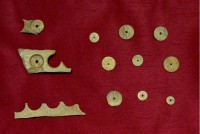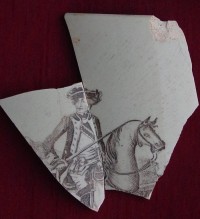 The 200-year-old vaginal syringe discovered underneath the historic landmark New York City Hall in lower Manhattan will find a permanent home under the same roof as thousands of other artifacts discovered during the constant churn of New York’s soil over the course of decades. Until now, artifacts discovered at excavations, usually surveys in advance of construction, have been spread out to 13 different institutions across the city, including Barnard College and Columbia University. Now the Landmarks Preservation Commission has created the New York City Archaeological Repository, a 1,400-square-foot, climate-controlled space at 114 W. 47th St., to host the artifacts in conservation conditions.
The 200-year-old vaginal syringe discovered underneath the historic landmark New York City Hall in lower Manhattan will find a permanent home under the same roof as thousands of other artifacts discovered during the constant churn of New York’s soil over the course of decades. Until now, artifacts discovered at excavations, usually surveys in advance of construction, have been spread out to 13 different institutions across the city, including Barnard College and Columbia University. Now the Landmarks Preservation Commission has created the New York City Archaeological Repository, a 1,400-square-foot, climate-controlled space at 114 W. 47th St., to host the artifacts in conservation conditions.
The last single location in New York to host the city’s archaeological patrimony was New York Unearthed, a privately-funded museum that closed in 2005. The museum was created by property owners the William Kaufman Organization as part a deal with the city. They would get to build on land known to be replete with rare archaeological artifacts from the earliest days of New Amsterdam without having to submit to an Environmental Quality Review. In return, they would fund a history museum on the first floor. The next owners honored the agreement, but when they sold the building in 1999, the new owners wanted nothing to do with the museum. They let it stay in place without paying rent or utilities, but they refused any further funding.
 After the museum folded in 2005, the massive collection of two million artifacts that were once on display in the 1,400 square foot space were rescued by the New York State Museum in Albany. A few pieces are on display there, but almost the entire collection is in storage in steel cabinets.
After the museum folded in 2005, the massive collection of two million artifacts that were once on display in the 1,400 square foot space were rescued by the New York State Museum in Albany. A few pieces are on display there, but almost the entire collection is in storage in steel cabinets.
It seems like for now at least, the new repository will be much the same: a place to store, catalog and study. It’s not a museum and will not be open to the public. Scholars and museums will be allowed to examine pieces upon request. Archaeologists are glad to get the opportunity to do their research in one location and to be able to do comparative analysis of related artifacts. It won’t be complete without the Albany collection, however, so I hope there are some long-term plans afoot to reunite all of New York’s material culture.
 The property for the repository was donated by the Durst Organization, a big real estate company that is still family run and which boasts a strong complement of history nerds in the family. The land was donated in honor of Nan Rothschild, a member of the Durst family and an anthropology professor at Barnard. An earlier Durst, Mr. Seymour B. Durst, built up a collection of New Yorkiana — historic photographs, postcards, maps, newspapers, assorted memorabilia — so vast that by the time he died in 1995, it filled all five floors of his townhouse. The Durst family donated the collection and funds to conserve it to the Avery Architectural & Fine Arts Library at Columbia University, where it is now known as the Seymour B. Durst Old York Library Collection. The Durst Organization is also funding a massive digitization project. When it’s complete, the entire collection will be made available online for scholars and the general public.
The property for the repository was donated by the Durst Organization, a big real estate company that is still family run and which boasts a strong complement of history nerds in the family. The land was donated in honor of Nan Rothschild, a member of the Durst family and an anthropology professor at Barnard. An earlier Durst, Mr. Seymour B. Durst, built up a collection of New Yorkiana — historic photographs, postcards, maps, newspapers, assorted memorabilia — so vast that by the time he died in 1995, it filled all five floors of his townhouse. The Durst family donated the collection and funds to conserve it to the Avery Architectural & Fine Arts Library at Columbia University, where it is now known as the Seymour B. Durst Old York Library Collection. The Durst Organization is also funding a massive digitization project. When it’s complete, the entire collection will be made available online for scholars and the general public.
I can’t help but hope that Durst attitude will rub off on the repository plan, expanding it so that millions of New York City artifacts will be all together again and on display for the public to enjoy.
As a writer, I can’t help but wonder how you lose that! Thank you so much for this blog, it’s marvelous 🙂